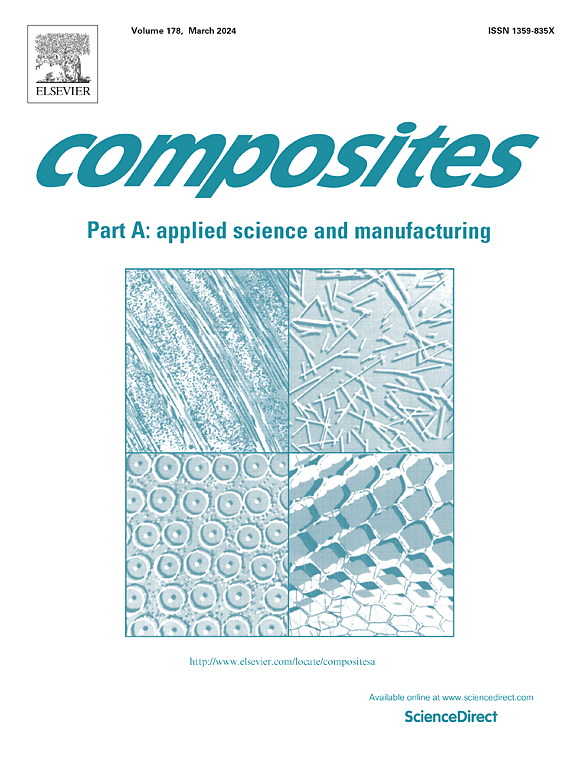Regulating SiO2 interlayer morphology towards synergistically reinforced dielectric properties and thermal conductivity in Si/PVDF composites
IF 8.1
2区 材料科学
Q1 ENGINEERING, MANUFACTURING
Composites Part A: Applied Science and Manufacturing
Pub Date : 2025-04-02
DOI:10.1016/j.compositesa.2025.108893
引用次数: 0
Abstract
Polymeric composites integrating large dielectric constant (ε), minimal loss with elevated breakdown strength (Eb) and thermal conductivity (TC), exhibit concern in electrical and power industry. To enhance the TC and Eb while suppressing loss in silicon (Si)/poly (vinylidene fluoride, PVDF), the Si@silica (SiO2) was prepared by high-temperature oxidation, and subsequently doped into PVDF. The Si@SiO2/PVDF displays lower loss since the SiO2 layer prevents direct contact between Si particles, inhibiting long-distance electron migration. Moreover, the SiO2 introduces traps to immobilize charge carriers, elevating the Eb. In particular, changing the amorphous SiO2 shell to crystalline one accelerates phonon transport, leading to enhanced TC. The dielectric parameters and TC of the Si@SiO2/PVDF can be synergistically tuned by adjusting the SiO2′ morphology and thickness. The theoretical calculation uncovers the underlying mechanisms for both charge and phonon transport in the composites. This developed Si@SiO2/PVDF composites with excellent dielectric performances and large TC showcase widespread applications.
调控SiO2层间形态,协同增强Si/PVDF复合材料的介电性能和导热性能
聚合物复合材料具有大介电常数(ε)、小损耗、高击穿强度(Eb)和高导热系数(TC)等特点,在电力工业中受到广泛关注。为了提高TC和Eb,同时抑制硅(Si)/聚偏氟乙烯(PVDF)中的损耗,通过高温氧化法制备Si@silica (SiO2),并将其掺杂到PVDF中。Si@SiO2/PVDF显示较低的损耗,因为SiO2层阻止了Si颗粒之间的直接接触,抑制了远距离电子迁移。此外,SiO2引入陷阱来固定载流子,提高Eb。特别是,将非晶SiO2壳层转变为结晶壳层加速了声子输运,导致TC增强。通过调整SiO2的形貌和厚度,可以协同调节Si@SiO2/PVDF的介电参数和TC。理论计算揭示了复合材料中电荷和声子输运的基本机制。研制的Si@SiO2/PVDF复合材料具有优异的介电性能和较大的TC,具有广泛的应用前景。
本文章由计算机程序翻译,如有差异,请以英文原文为准。
求助全文
约1分钟内获得全文
求助全文
来源期刊

Composites Part A: Applied Science and Manufacturing
工程技术-材料科学:复合
CiteScore
15.20
自引率
5.70%
发文量
492
审稿时长
30 days
期刊介绍:
Composites Part A: Applied Science and Manufacturing is a comprehensive journal that publishes original research papers, review articles, case studies, short communications, and letters covering various aspects of composite materials science and technology. This includes fibrous and particulate reinforcements in polymeric, metallic, and ceramic matrices, as well as 'natural' composites like wood and biological materials. The journal addresses topics such as properties, design, and manufacture of reinforcing fibers and particles, novel architectures and concepts, multifunctional composites, advancements in fabrication and processing, manufacturing science, process modeling, experimental mechanics, microstructural characterization, interfaces, prediction and measurement of mechanical, physical, and chemical behavior, and performance in service. Additionally, articles on economic and commercial aspects, design, and case studies are welcomed. All submissions undergo rigorous peer review to ensure they contribute significantly and innovatively, maintaining high standards for content and presentation. The editorial team aims to expedite the review process for prompt publication.
 求助内容:
求助内容: 应助结果提醒方式:
应助结果提醒方式:


